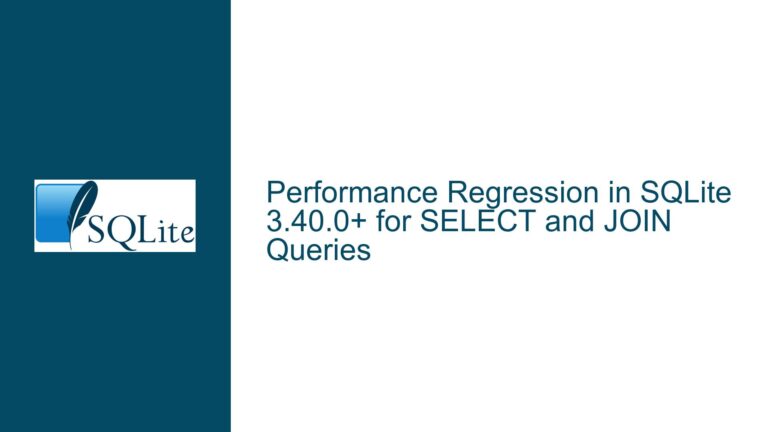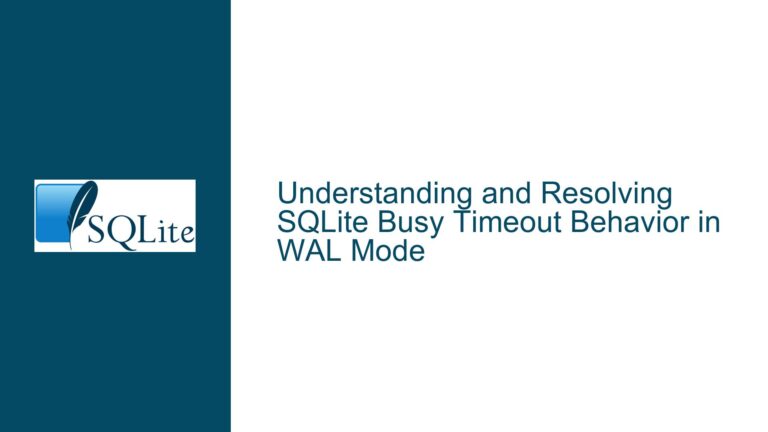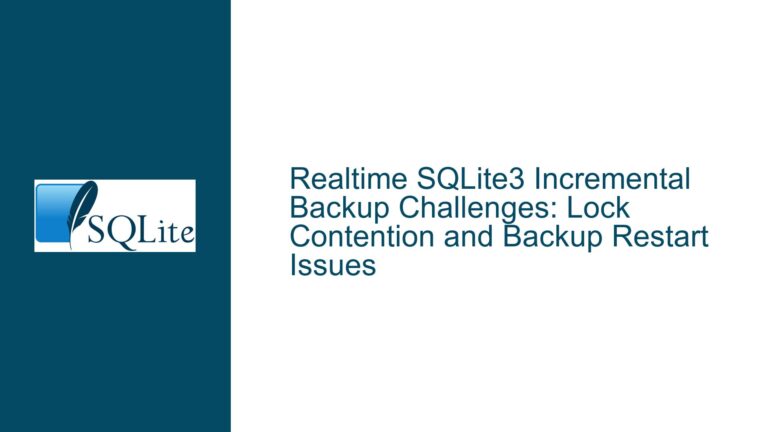and Resolving SQLite Query Performance Discrepancies on First Run
SQLite Query Performance Discrepancy on Initial Execution
When executing a SQLite query, it is not uncommon to observe a significant performance discrepancy between the first execution and subsequent runs. This phenomenon manifests as a slower initial execution time, followed by markedly faster execution times for identical queries. This behavior can be perplexing, especially when the same query, without any modifications, exhibits such variability in performance.
Consider a scenario where a query is designed to retrieve project details from a Project_List table, filtering based on specific conditions related to project dates and statuses. The query might look something like this:
SELECT ProjID, CID, Project_Name, Start_date,
Finish_Date, Target_Go_Live_Date,
BL_Start,BL_Finish, Ann_CapexP, Tot_CapexP,
Progress, Status, Project_Manager
FROM Project_List a WHERE
a.PMO_Board_Report != 'No'
AND
(
(
a.Target_Go_Live_Date > substr(date('now'),1,4) || '-01-15'
)
OR
(
a.Target_Go_Live_Date = '' AND a.Finish_Date > substr(date('now'),1,4) || '-01-15'
)
)
AND
a.InsertDate =
(
SELECT MAX(InsertDate) FROM Project_List WHERE ProjID = a.ProjID
)
group BY a.ProjID
;
Upon executing this query, the initial run might yield a real time of 4.195 seconds, with user and system times of 0.125000 and 0.750000 seconds, respectively. However, subsequent executions of the same query could result in significantly reduced real times, such as 0.834 seconds, 0.764 seconds, and 0.721 seconds, with corresponding reductions in user and system times.
This discrepancy is not due to any inherent flaw in the query itself but rather stems from underlying mechanisms related to how SQLite and the operating system manage data access and memory. Understanding these mechanisms is crucial for diagnosing and potentially mitigating such performance variations.
Operating System and SQLite Caching Mechanisms
The primary reason for the observed performance discrepancy lies in the caching mechanisms employed by both the operating system and SQLite. When a query is executed for the first time, the data required to fulfill the query must be read from the disk. Disk I/O operations are inherently slower compared to memory access, which contributes to the longer execution time observed during the initial run.
The operating system plays a significant role in this process. Modern operating systems employ a disk caching mechanism where recently accessed disk blocks are kept in memory. This means that after the first execution of the query, the relevant data blocks are likely to be present in the operating system’s cache. Subsequent executions of the same query can then benefit from this caching, as the data can be retrieved directly from memory, bypassing the slower disk I/O operations.
SQLite itself also utilizes a page cache to store recently accessed database pages. Each database file in SQLite is divided into fixed-size pages, and these pages are cached in memory to expedite future access. When a query is executed, SQLite first checks its page cache for the required pages. If the pages are not found in the cache, they are read from the disk and then stored in the cache for future use. This caching mechanism further contributes to the reduced execution times observed in subsequent query runs.
The combination of operating system disk caching and SQLite’s page caching results in a significant performance boost for repeated queries. However, this also means that the first execution of a query, which involves reading data from the disk, will invariably be slower.
Optimizing Query Performance Through Caching and Indexing
To address the performance discrepancy between the first and subsequent query executions, several strategies can be employed. These strategies focus on leveraging caching mechanisms and optimizing the database schema to minimize the impact of disk I/O operations.
One effective approach is to ensure that the database is properly indexed. Indexes can significantly reduce the amount of data that needs to be read from the disk, thereby speeding up query execution. In the context of the provided query, indexing the ProjID, InsertDate, and Target_Go_Live_Date columns could yield substantial performance improvements. For example, creating a composite index on (ProjID, InsertDate) would facilitate the efficient retrieval of the maximum InsertDate for each ProjID, as required by the subquery.
Another strategy involves preloading data into the cache. This can be achieved by executing a preliminary query that accesses the relevant data, thereby populating the operating system and SQLite caches before the actual query is run. While this approach does not eliminate the initial performance hit, it can help ensure that subsequent queries benefit from cached data.
Additionally, adjusting SQLite’s cache size can have a positive impact on performance. The PRAGMA cache_size command allows you to configure the number of database pages that SQLite keeps in memory. Increasing the cache size can enhance the likelihood that the required pages are already in memory, reducing the need for disk I/O.
Finally, it is important to consider the impact of database fragmentation. Over time, as data is inserted, updated, and deleted, the database file can become fragmented, leading to increased disk I/O overhead. Running the VACUUM command can help defragment the database, improving overall performance.
By implementing these strategies, it is possible to mitigate the performance discrepancy between the first and subsequent query executions, ensuring more consistent and efficient query performance in SQLite.






